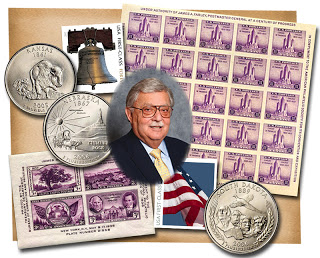
Besides attempting to get people to use these new stamps on current U.S. mail the Postal Service seems to be hoping that all would not be used for “goods or services.” Similar motivations led the government to finally admit that the “State Quarter” program is a wonderful profit center, as $6 billion was recorded as profit by November 2006.
The Postal Service, which sells stamps for “non use” to collectors, seized upon the idea that volumes of money from many collectors can pour into the market, and by not using the stamps, receive a “free loan” from the public, and not provide any service until the stamps are used.
Think how good this must appear to the “bean counters” at the Post Office. After one buys his “forever stamps” he or she will no doubt use some, put some in a drawer or just pile them away in order to “beat the cost” in years to come if postage rates increase. As with many items, stamps when purchased for future use seem to disappear. It is because we hide them away so carefully that even we cannot find them! Hence the Postal Service gets a “free loan” from these little pieces of paper, which are not put to any use.
The concept for the State Quarter program was different, yet after six or seven years of issuance it became a great source of a capital-free loan. The public, as well as collectors, put them away and never used them. Actually, when the coins were proposed it was to allow the public to find these new designs in circulation, accumulate as many different states and mintmarks, and keep them at face value. This idea came about in reaction to the vast commemorative programs in existence from 1983 to 1995, coins which were sold by the Mint at substantial profit. In retrospect, the quarters could always be spent at face value. Also the proposal I made suggested that part of the design would include the name of the state, the capital of each state, the major product or landmark of each state, and whatever else (as an addition) which would teach the owner some important details about each state. In other words, it was a learning tool as well as a piece of money.
Selling commemorative stamps is not new to the Post Office. During the recession period of 1933-1934, James A. Farley, Franklin D. Roosevelt’s postmaster general, created commemorative stamp issues to bail the Post Office out of bankruptcy. He caused to be issued commemoratives for the Century of Progress Exposition, non-perforated sheets and special plate blocks, Transportation Series, Presidents of the United States Series, Famous Americans Series, and on and on. Collectors invested heavily in these various series, never used them for postage and thereby provided a “free loan” to support the bankrupt Post Office.
Oddly the Postal Service, as of now, did not suggest a design change to stimulate special interest or history, but instead offers a new way to invest.
Imitation is the greatest form of flattery, but the Postal Service in this case “missed the mark.” Rather than make the program more collectible, they included the possibility of investment. Really not a job for the Post Office. Investment ideas belong at the Treasury.
It seems to me that each government agency will soon find a way to profit from collectors as the above is the case, rather than encourage a new breed of collectors.





